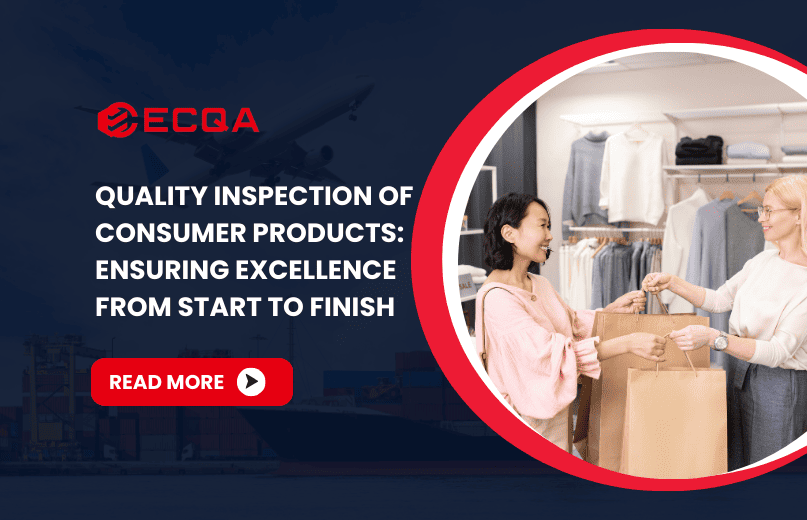
5 Types of Quality Inspections for Consumer Products

The process of quality inspection of consumer products encompasses a range of inspection services and methodologies designed to ensure that every product meets rigorous industry standards and customer expectations.
A comprehensive quality control strategy safeguards product quality by monitoring each stage in the production process, from raw materials through to finished goods. Here, we dive deep into the intricacies of quality inspection of consumer products to understand its importance and the methods involved.
Understanding Quality Inspection of Consumer Products
Quality inspection is a thorough inspection process aimed at validating that a consumer product not only fulfills its functional requirements but also aligns with industry standards for safety, durability, and aesthetics. By meticulously inspecting each item in the production cycle, companies can catch and address potential issues before they affect customers’ expectations. A strong quality assurance protocol also contributes to brand loyalty, cost savings, and smooth supply chain operations.
The Role of Quality Control in Consumer Products
Quality control (QC) is central to maintaining product quality at each step of the manufacturing process. In consumer products, QC involves monitoring the raw materials, overseeing manufacturing processes, and conducting rigorous testing and evaluation of finished goods. These actions ensure that each product not only meets design specifications but also provides consumers with a safe and reliable product experience.
Quality control can be broken down into various inspections, including pre-shipment inspections and random sampling, to address specific aspects of consumer goods at various production stages.
Types of Quality Inspections for Consumer Products
To maintain quality assurance throughout the production process, different types of inspections are conducted. Each type of product inspection service focuses on distinct elements of quality control, ensuring that the product meets the defined criteria for consumer safety and usability.
1. Pre-Production Inspection (PPI)
A pre-production inspection is conducted before the manufacturing process begins. It involves inspecting raw materials and components to ensure they meet quality requirements. This step allows the inspection team to identify any potential issues with the supply chain and production process that could affect product quality later on. Key activities in a PPI include:
- Assessing raw materials and parts for quality and consistency.
- Reviewing manufacturing processes to confirm they align with the desired product standards.
- Establishing a foundation for future inspections and quality assurance.
2. In-Process Inspection (IPI)
An in-process inspection, also known as during-production inspection (DUPRO), occurs while products are being manufactured. This stage provides real-time insights into production quality, allowing immediate corrections to be made if defects are identified. An IPI includes:
- Monitoring manufacturing processes to ensure consistency.
- Checking for defects or deviations from industry standards.
- Reducing the likelihood of extensive issues at the end of the production process.
3. Pre-Shipment Inspection (PSI)
Pre-shipment inspections are one of the most critical stages in quality control for consumer goods. A PSI takes place once the order is completed and ready for shipment, ensuring that finished goods meet the required standards. During a PSI, inspectors verify:
- The quantity and quality of the products.
- Compliance with industry standards and customer specifications.
- Proper labeling and packaging integrity to ensure safe transport and compliance with supply chain requirements.
4. Container Loading Inspection (CLI)
For businesses focusing on consumer goods exports, container loading inspections are essential. The CLI process ensures that products are properly loaded and secured for transport, minimizing the risk of damage during transit. CLI typically involves:
- Verifying product quantity and packaging.
- Ensuring proper loading techniques to prevent product movement and damage.
- Confirming that the shipment complies with international shipping regulations.
5. Random Sampling Inspection
Random sampling inspections are used to inspect a sample from a larger batch, offering insights into overall product quality without evaluating every single item. This is especially useful for large orders where comprehensive inspections might be impractical. Benefits of random sampling include:
- Efficient quality assurance across large quantities of products.
- Early detection of systemic issues within the production process.
- Maintaining high-quality standards with reduced inspection time.
Key Elements of the Quality Inspection Process
The inspection process is a structured approach designed to cover all aspects of product quality. Below are the essential elements of an effective inspection protocol for consumer products.
Inspection Checklist
A detailed inspection checklist is crucial to the quality inspection process. This checklist specifies each item that needs verification, ensuring no detail is overlooked. An effective checklist includes:
- Product specifications such as dimensions, color, and weight.
- Functional testing criteria, confirming the product operates as intended.
- Aesthetic standards to ensure consistency in consumer goods appearance.
- Compliance requirements, including safety standards and regulatory criteria.
Inspection Report
A comprehensive inspection report captures the results of each inspection phase, providing a record of compliance and highlighting any issues identified. This report typically includes:
- Visual evidence of product defects or deviations.
- Summary of tests performed and outcomes.
- Recommendations for corrective actions.
- Verification of industry standards compliance.
A reliable inspection report enables importers, manufacturers, and suppliers to make informed decisions based on current quality metrics, ensuring every consumer product meets customer expectations.
Advantages of Quality Inspection in Consumer Products
Investing in quality inspection services for consumer products brings several advantages to both businesses and end consumers. Below are some of the primary benefits:
Reduced Defects and Returns
Thorough product inspections help detect and eliminate defects before products reach the consumer. This minimizes costly product returns, strengthens customer satisfaction, and upholds brand reputation.
Compliance with Industry Standards
In many markets, consumer goods must comply with specific industry standards and regulations. Through rigorous quality control, companies can ensure their products meet these criteria, avoiding legal issues and penalties.
Enhanced Customer Satisfaction
By ensuring that every finished good aligns with customers’ expectations, companies build trust with their consumer base, improving satisfaction and encouraging repeat business.
Cost Savings and Efficiency
Addressing issues during the production process rather than post-production saves both time and money. Quality inspections help prevent costly recalls, reworks, and reputational damage associated with defective consumer goods.
Industries We Serve: Comprehensive Product Quality Inspections for Every Sector
ECQA provides quality inspection services across a wide range of industries, ensuring that every consumer product meets industry standards for quality, safety, and performance. Below are the main industries we serve and the specific types of products inspected within each sector.
1. Household and Personal Care
Our inspections in the household and personal care sector cover a variety of products essential to daily life. We focus on ensuring these items meet high standards for safety, durability, and user satisfaction. Products inspected in this category include:
- Electronics – Testing for functionality, reliability, and regulatory compliance. Examples: electric shavers, hairdryers, and handheld blenders.
- Home Textiles – Ensuring fabric quality, durability, and compliance with industry standards. Examples: bedsheets, curtains, and cushion covers.
- Kitchen Appliances – Inspecting for performance, durability, and adherence to regulatory standards.Examples: coffee makers, air fryers, and toasters.
- Beauty and Cosmetic products – Verifying product quality and alignment with health and regulatory requirements.Examples: skincare creams, makeup kits, and hair care products.
- Kitchenware and Tableware – Checking for material quality, durability, and adherence to regulatory standards. Examples: ceramic plates, glassware, and cutlery sets.
2. Consumer Products
Our consumer product inspections ensure that everyday goods meet quality and safety standards. From toys to fitness equipment, our inspections cater to various needs in this diverse sector. Products inspected include:
- Toys – Conducting safety tests to ensure compliance with child safety regulations. Examples: action figures, educational toys, and stuffed animals.
- Furniture – Verifying structural integrity, material quality, and compliance with furniture safety standards. Examples: office chairs, dining tables, and storage cabinets.
- Lighting – Inspecting for brightness, durability, and energy efficiency compliance. Examples: LED bulbs, floor lamps, and desk lights.
- Food – Ensuring products meet food safety standards, including packaging integrity. Examples: packaged snacks, canned goods, and beverages.
- Fitness Equipment – Testing for durability, performance, and safety. Examples: dumbbells, yoga mats, and treadmills.
3. Apparel and Accessories
For the apparel and accessories industry, we provide thorough inspections to maintain quality, durability, and compliance with industry standards. Products inspected include:
- Garments – Verifying stitching quality, material integrity, and compliance with clothing standards. Examples: t-shirts, jeans, and sportswear.
- Footwear – Inspecting for durability, fit, and material quality. Examples: running shoes, sandals, and formal leather shoes.
- Accessories – Ensuring the quality of materials, finishes, and safety compliance. Examples: handbags, belts, and jewelry items.
- Luggage and Bags – Checking for material strength, zipper functionality, and structural integrity to ensure durability and compliance. Examples: suitcases, backpacks, and travel bags.
The quality inspection of consumer products is a vital component of maintaining high standards in today’s global market. Companies that invest in robust quality control practices benefit from enhanced brand reputation, cost savings, and improved customer satisfaction. By following best practices and choosing the right inspection services, businesses can ensure that every finished product delivered to consumers is safe, reliable, and consistent with industry standards.
Ready to elevate your product quality? ECQA offers expert inspection services tailored to meet the unique needs of each industry. Contact us today to learn how our services can help your business achieve excellence and build trust with your consumers. Email us at sale@ecqa.com to get started!

 Request Free Sample Report
Request Free Sample Report